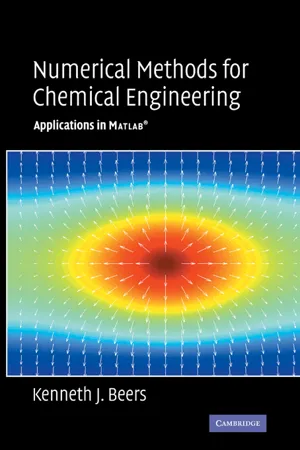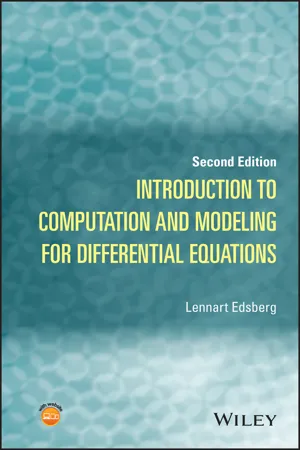Technology & Engineering
Boundary Value Problem
A boundary value problem in engineering refers to a type of mathematical problem that involves finding a solution to a differential equation subject to specified boundary conditions. These conditions are typically defined at the boundaries of the problem domain. Boundary value problems are important in engineering as they help in modeling and solving real-world physical phenomena, such as heat conduction and fluid flow.
Written by Perlego with AI-assistance
Related key terms
1 of 5
5 Key excerpts on "Boundary Value Problem"
- Nayef Ghasem(Author)
- 2023(Publication Date)
- CRC Press(Publisher)
9 Boundary Value Problems of Ordinary Differential EquationsDOI: 10.1201/9781003360544-9A Boundary Value Problem (BVP) is a system of ordinary differential equations (ODEs) with a solution and derivative values defined at more than one point. This chapter uses finite differences and shooting methods to convert BVPs into algebraic equations. Furthermore, the Thomas algorithm is presented and explained in this chapter. Manual calculations are compared to Python and Simulink programming predictions, where the code is given for each case.Learning Objectives
- Identify a BVP.
- Implement the shooting method to solve a BVP.
- Apply the finite difference method.
- Use the Thomas algorithm to solve a BVP.
- Utilize Python and Simulink/MATLAB to tackle a BVP.
9.1 Introduction
A differential equation is defined as an equation that relates one or more unknown functions and their derivatives in mathematics. ODEs can only be solved given additional information, called boundary conditions (BCs). If the BCs are specified at the same independent variable value (e.g., x ), the problem is an initial value problem (IVP). Some BCs are specified at different values for the independent variable, such as initial and final positions of x ; these are called BVPs. The differential equation contains one or more terms and the derivatives of one dependent variable concerning another independent variable [1 ]. We often see them for problems where conditions are specified at various locations in space rather than time.(9.1)= fd yd x( x )Here, ‘x ’ is an independent variable and ‘y ’ is a dependent variable, such as(9.2)= 5 xd yd xA differential equation contains derivatives that are either partial derivatives or ordinary derivatives. BVPs commonly arise in many engineering subjects, such as heat transfer, mass transfer, and reactor design. An example of the BVP is the steady-state temperature distribution along a rod hung between two plates of different temperatures (Figure 9.1 ). A BVP comprises a differential equation subject to a given set of BCs. BCs are prescribed for the unknown variable and its derivatives at more than one point [2- eBook - PDF
Numerical Methods for Chemical Engineering
Applications in MATLAB
- Kenneth J. Beers(Author)
- 2006(Publication Date)
- Cambridge University Press(Publisher)
6 Boundary Value Problems Boundary Value Problems (BVPs) involve the solution of ODEs or partial differential equa- tions (PDEs) on a spatial domain, subject to boundary conditions that hold on the domain boundary. Many problems from solid and fluid mechanics, electromagnetics, and heat and mass transfer are expressed naturally as BVPs. The forms of these differential equations often resemble each other because they arise from similar conservation principles. Here the emphasis is upon BVPs that arise from problems in transport phenomena. This chapter focuses upon real-space methods, in which a computational grid is overlaid upon the domain. The BVP is then converted into a set of ODEs for a time-dependent problem or a set of algebraic equations for a steady problem. This technique can be used even when no analytical solution exists, and can be extended to BVPs with multiple equations or complex domain geometries. Here, the focus is upon the methods of finite differences, finite volumes, and finite elements. These methods have many characteristics in common; therefore, particular attention is paid to the finite difference method, as it is the easiest to code. The finite volume and finite element methods also are discussed; however, as the reader is most likely to use these in the context of prewritten software, the emphasis is upon conceptual understanding as opposed to implementation. BVPs from conservation principles Let ϕ(r , t ) be some time-varying field, i.e., a function that assigns to each position r and time t a unique value ϕ(r , t ). Common examples of fields in chemical engineering include ϕ = ρ mass density ϕ = ρ v linear momentum density (6.1) ϕ = 1 2 ρ |v| 2 + ρ ˆ u total kinetic and internal energy density ϕ = c i concentration of species i Each of these fields represents the density of some quantity . - eBook - PDF
Engineering Electromagnetics
Pergamon Unified Engineering Series
- David T. Thomas, Thomas F. Irvine, James P. Hartnett, William F. Hughes(Authors)
- 2013(Publication Date)
- Pergamon(Publisher)
5 Boundary Value Problems INTRODUCTION One day in the not too distant future you will all be out in the cruel business world. There your boss (or associate) will come to you with a problem—except it won't really be a problem in the sense with which you are familiar. Instead it will be a vague, half formulated notion your boss has about something. For example: In one of his pet projects, Y.B. (your boss) is in charge of designing a multi-fibrilatingflim-flamcircuit. The previous versions of this circuit make extensive use of Vacuum Tube Diodes such as shown in Fig. 5-1. Your boss says he has heard of a Child's-Langmuir Law relating current and voltage in such a diode as, (5.1) where K is a constant depending, he supposes, on size of the diode plates, their separation, the presence or absence of a vacuum in the tube, conductivity of the plates, the presence of a Republican administration in Washington and one or more universal Fudge factors. Since Y.B. wants to use this diode device in his circuit (or does he expect you to design him a better device? He really never made that clear!) he must at all costs have the Child's-Langmuir Law and the constant, K. Any other information you might discover in your studies will, of course, be noted for the future. Well, there you have it. A nice orderly, well-stated problem it is not; you're not even sure what it is your boss wants to know, aside from a definite interest in the Child's-Langmuir Law. The question is, how do we translate this nebulous discussion with your boss into a mathematical, solvable problem which will answer the questions he may have? This is the world of the Boundary Value Problem. Each Boundary Value Problem must be considered separately —but many similarities between problems provide for organization of the many considerations 143 144 Boundary Value Problems into some basic categories. Generally, the problem analysis divides into two major, but not necessarily separate parts: 1. - eBook - PDF
- Douglas Henderson(Author)
- 2012(Publication Date)
- Academic Press(Publisher)
Chapter 4 Boundary-Value Problems DOUGLAS HENDERSON I. Introduction 262 II. Some Typical Boundary-Value Problems 263 A. Elastic String 263 B. Heat Equation 264 C. Potential Problems 264 D. Schroedinger's Equation 265 E. Some Further Comments 265 III. The D'Alembert Solution of the Wave Equation 268 IV. Separation of Variables 269 A. Plucked String 269 B. Comments Regarding the Separation of Variables 273 C. Three Heat Conduction Problems 275 D. Relation to the D'Alembert Solution 279 V. Eigenvalues, Eigenfunctions, and Expansion Problems 280 A. Orthogonal Sets of Functions 281 B. Abstract Vector Space 284 C. Sturm-Liouville Problem 285 D. Another Heat Problem 290 VI. Boundary-Value Problems in Cylindrical Coordinates 291 A. Laplace's Equation in Cylindrical Coordinates 292 B. Bessel Functions 292 C. Modified Bessel Functions 295 D. Some Relations for Bessel Functions 296 E. Orthogonality of the Bessel Functions 298 F. Three Examples 300 VII. Boundary-Value Problems in Spherical Coordinates 304 A. Laplace's Equation in Spherical Coordinates 304 B. Legendre Polynomials 306 C. Associated Legendre Functions 307 D. Orthogonality of the Legendre Functions 309 E. The Addition Theorem for Spherical Harmonics 310 F. Three Examples 312 261 262 Douglas Henderson VIII. Green's Functions A. Introductory Example B. Green's Function for the Sturm-Liouville Operator . C. Solution of Potential Problems by Green's Functions D. Green's Function for a Sphere IX. Laplace Transform Methods A. A Heat Problem in a Semiinfinite Rod B. A Heat Problem in a Finite Rod . . . X. Conformal Mapping 316 316 319 324 326 327 328 329 331 References 335 I. Introduction The solution of a differential equation subject to some conditions on the boundary of the domain of the system (so-called boundary conditions or, in the case of time, initial conditions, which are merely a type of bound-ary condition) is, perhaps, the most common problem in applied mathe-matics. - Lennart Edsberg(Author)
- 2015(Publication Date)
- Wiley(Publisher)
4 NUMERICAL METHODS FOR Boundary Value ProblemS In this chapter, numerical methods for Boundary Value Problems (BVPs) are described. Most of the methods are presented for second-order ordinary differential equations (ODEs) as such problems are very common in applications. However, generalization to higher order ODEs and other types of BVP formulations are also presented in various application problems. The independent variable is changed from t to x, as many BVPs are formulated for 1D space-dependent problems. A nonlinear second-order ODE d 2 u dx 2 = f ( x, u, du dx ) (4.1) has a general solution that depends on two arbitrary constants C 1 and C 2 u = u(x, C 1 , C 2 ) (4.2) In general, we cannot find the analytic solution. Hence, there is no explicit expres- sion of the solution in the form (4.2) in which values of the constants C 1 and C 2 can be inserted. To obtain a unique solution, we therefore need two conditions. In Chapter 3, these conditions were given as initial conditions. In this chapter, we show how appropriate boundary conditions (BCs) define a solution that can be computed approximately with numerical methods. Just like an initial value problem (IVP), a BVP usually contains a number of parameters occurring both in the right hand side function f (x, u, u ′ ) and/or in the BCs. As a consequence, parameter studies are needed for BVPs, too. Hence, it is necessary to have accurate, efficient, and robust methods. Introduction to Computation and Modeling for Differential Equations, Second Edition. Lennart Edsberg. © 2016 John Wiley & Sons, Inc. Published 2016 by John Wiley & Sons, Inc.
Index pages curate the most relevant extracts from our library of academic textbooks. They’ve been created using an in-house natural language model (NLM), each adding context and meaning to key research topics.




